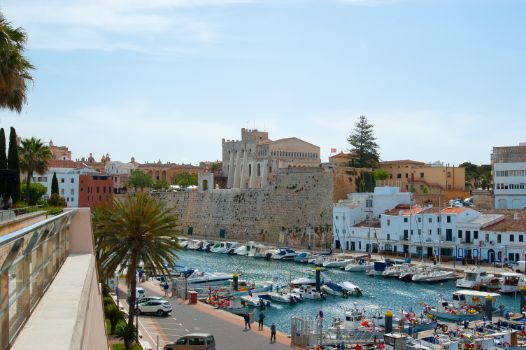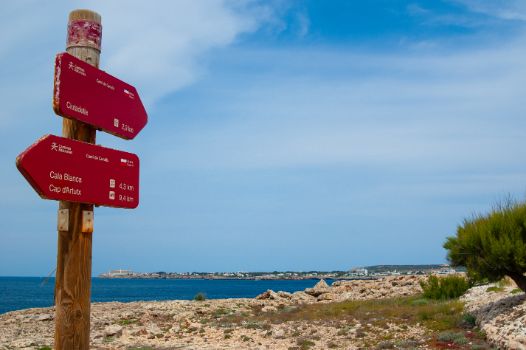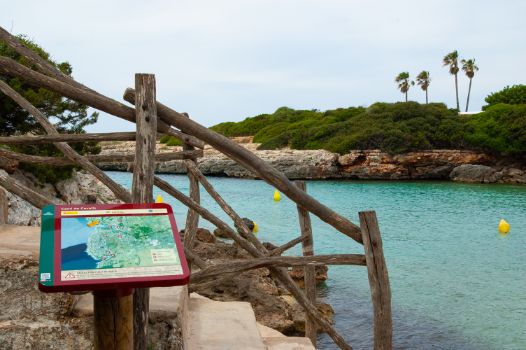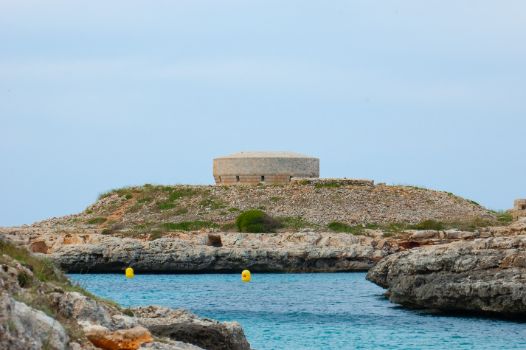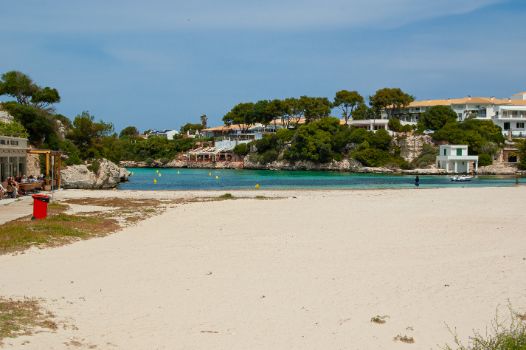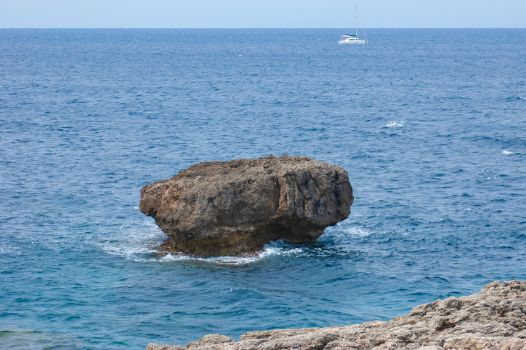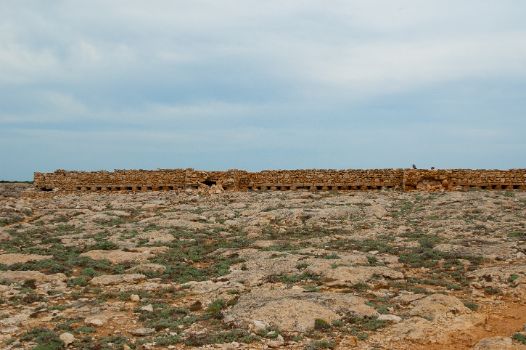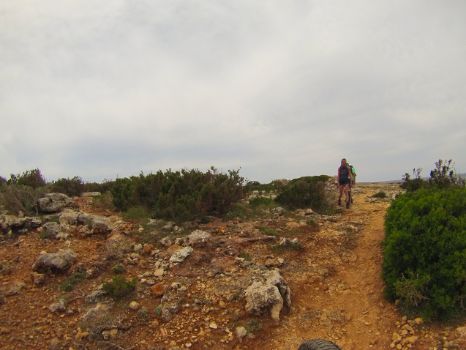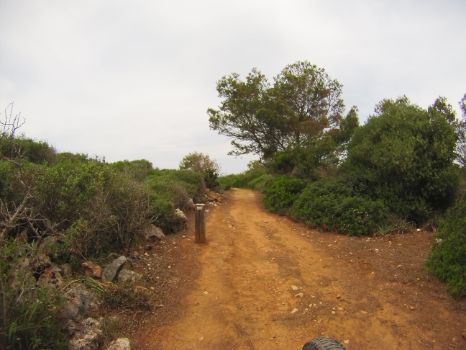
Net of Natural
Trails

Stage 11: Ciutadella - Cap d´Artruxt
Description
Menorca's west coast, dotted with beautiful beaches and coves with spectacular hidden corners
Just over 13 kilometres separate the beginning and end of this stage, between Ciutadella and Cap d'Artrutx. Along the way you will pass the beach of Sa Caleta d'en Gorries, the Santadria Cove and the Cala Blanca Cove, idyllic seaside spots that rival the natural wealth of the Son Olivaret Public Estate or the cultural heritage of the pre-Talaiotic naveta of Cala Blanca.

The start of stage 11 of the Camí de Cavalls Nature Trail begins, as usual, next to the Nature Trail information board located on this occasion in the Menorca Blava car park next to the spectacular Port de Ciutadella.
The route runs through the city of Ciutadella, the old capital of Menorca, advancing along Carrer de Santa Bàrbara, reaching Plaça la Font, continuing along Carrer de sa Muradeta, which plunges into the heart of Ciutadella. You will arrive at Plaça des Born, with its 22-metre-high obelisk towering over of the square and the town hall. The town hall itself is beautiful building with views over the port and which was formerly the royal fortress which, in turn, was built on the site of an ancient Muslim castle.
At this point of the journey, and before continuing your adventure along the Camí de Cavalls Nature Trail, you should visit the Santa Maria Cathedral. It is a Gothic church built by Alfonso III of Aragon after the conquest of Menorca by Christian troops on the site the an old mosque. After living and suffering through the different events that took place in the city, from the Turkish attack in 1558 to the Spanish Civil War in 1939, today the cathedral looks spectacular and rejuvenated after painstaking restoration work.

If you are doing the Camí de Cavalls by bicycle, cycle along the Plaça dels Pins cycle lane, continuing along Carrer de Mallorca, which includes a cycle lane has also been created for cyclists and a pavement for hikers. When you reach a roundabout, continue along Carrer Ciutadella - Sa Caleta, using the same infrastructures mentioned above. Further on, at the next roundabout you must turn right onto Avinguda del Mar, which shortly afterwards will be called Via Mestre Vives, and which will take you out of the city to Ciutadella's Outer Harbour.
The ferries that connect Menorca with the mainland, among other destinations, sail from this port; in 2011 a dyke was built to minimise the abrupt oscillations in sea level known as rissagues.
Moving forward with the coast on the right and the houses of Sa Caleta on the left, follow the signs to leave this urban area and, after leaving behind the Torre des Castellar, also known as Torre Santadria, and an old bunker, the trail will lead you to the paradisiacal beach of Sa Caleta or Sa Caleta d'en Gorries.
After enjoying this small beach or even chilling in it for a little bit, climb up away from the beach continue along a new urban stretch following the Carrer del Signe Lléo. To the right, the path is guarded by the characteristic azure waters, thanks to the good health of the extensive underwater Neptune grass (Posidonia oceanica) meadows which surround the island.
Shortly afterwards, after a stroll through the houses, you will go down some stairs that lead to Carrer de sa Platja, which will take you to the beach of Cala Santadria. Once again, the rush is put aside to enjoy this marvellous place with all the services.

Then, you will have to climb again and, after two turns to the right, the route leaves the asphalt road and continues along a dirt track that gradually turns into a path. For a short while you walk through bushes and trees and then turn left and walk parallel to a dry stone wall that reveals a new hidden beach, Es Clot de Sa Cera, where a small staircase leads to the water and entice you to go for a swim.
We return to a new urban section, which forces us to walk through the town of Cala Blanca, mostly along the Avinguda de Cala Blanca. With the Mediterranean Sea always on your right, you finally reach the the famous Cala Blanca beach, where, in addition to enjoying its azure waters and white sands, you can visit the nearby archaeological site known as Naviforme de Cala Blanca. It consists of the remains of a dwelling with an elongated floor plan dating back to the Bronze Age which centuries later it was used as a warehouse, according to the different objects found here, which are currently on display in the Museum of Menorca.
Leaving the cove and the site behind, the trail continues along an urban section. This ends shortly afterwards, at the Mirador des Cap de Sa Pared, enjoying its panoramic views and continuing the journey along a dirt track that crosses two stone walls traditionally used to separate Menorcan estates.
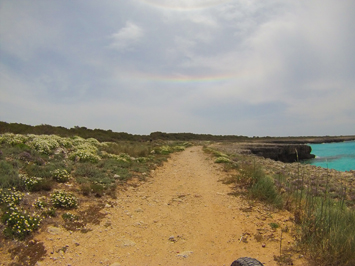
From this point onwards, the urban landscape becomes a natural and wild landscapes in which bushes strive to grow, although the grow gradually smaller as they come close to the coast. A succession of Menorcan gates lead to a quiet and tranquil environment. After crossing one of those gates, an information board informs the walker that he is about to enter the Son Olivaret Public Estate. This area has an important environmental value, as well as a rich flora and wildlife. A signpost indicates that the final destination of this eleventh stage is just 900 m from here. The remains of a Spanish Civil War bunker are located next to the signpost. A new Menorcan gate indicates that, once you pass it, you leave the Son Olivaret Public Estate at the same time as the Cap Negre Site of Community Importance (SCI). Immediately after this gate, the Nature Trail information board marks the end of this exciting stage.
Links of interest
Profile

(Calculated according to the MIDE criteria for an average excursionist with a light load)
Highlights
Ciutadella
It is the most populated city of Menorca and was once the capital of the island. Its name derives from the Latin civitas, which means “city”, and more specifically from its diminutive civitella. The area has been inhabited for many centuries, and numerous prehistoric remains from the Talaiotic period are still preserved today. The most outstanding of these remains is the Naveta des Tudons, a collective tomb built in a single nave that resembles an upside-down boat.
Little remains of the Muslim period, which ended when the island was passed into the hands of the Crown of Aragon in 1287. The town suffered a great sacking in 1558 by the Turkish fleet, belonged to the British for almost a century, and then stabilised and its population has grown until the present day.
Due to the numerous changes that have taken place throughout its history, the Santa Maria Cathedral is the only medieval cathedral that is still standing today. The old quarter of Ciutadella you to stroll through its streets. Its centre is Plaça des Born, with its obelisk, as a compass needling, towering over the old town, the town hall and the old port (Port Vell).
Currently, the new port of Ciutadella, located on the southern outskirts of the town, concentrates the commercial and passenger sea traffic. The patron saint festivities in Ciutadella are held on midsummer in honour of Sant Joan (St. John), and different celebrations take place on the days before and after.
Naveta des Tudons
The Naveta des Tudons is one of the most representative symbols of the island of Menorca and undoubtedly one of the best known internationally. These stone constructions date from the Bronze Age (1600 - 850 BC) and was used as a collective burial site. It is one of the best examples of Menorcan Talaiotic culture.
The navetas identified today are concentrated on the east and west ends of the island of Menorca, on fertile land, and many of them are even near the source of one the small river basins that run through the island. The Naveta de Es Tudons is the most iconic construction of this type, in the shape of an inverted boat and with two floors. The bodies were placed inside, wrapped in shrouds of cloth or animal skin and thoroughly tied with braided ropes.
Of course, the Naveta has inspired many legends and tales. The most popular legend. passed down from generation to generation of Menorca, states that two giants fell in love with the same woman and decided to compete for her love, telling her to choose one of them. One of them would build the Naveta and the other built a well. When the second giant finished building the well, shouted from the bottom that he had found water. Hearing this, the first giant threw the last stone he was going to use to complete the Naveta down the well, blocking it and trapping his rival inside forever. This is why the Naveta de Es Tudons is missing a stone.



